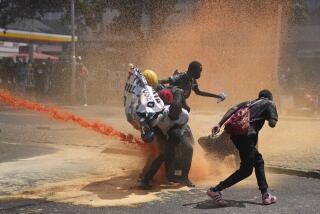Official’s Funeral Erupts into Worst Kenya Unrest in Years : Africa: How did the foreign minister die? The question has spurred days of disturbances.
- Share via
NAIROBI, Kenya — A memorial service here for Kenya’s Foreign Minister Robert J. Ouko, who died last week under mysterious circumstances, erupted Friday into a rock-throwing melee and extended looting in the country’s worst civil unrest in years.
Police and members of the government’s paramilitary General Services Unit spent most of the day trying to disperse demonstrators and looters in downtown Nairobi with tear gas and clubs.
Roads out of the city center were jammed with buses, taxis and other vehicles taking panicked bystanders away from the fray. Many cars were simply abandoned on the district’s wide boulevards. Some vehicles, including taxis carrying passengers, were attacked by the mob and smashed.
There were no preliminary reports of deaths. But scores of people suffered injuries from rocks thrown by demonstrators and truncheons wielded by police.
Although Friday’s events followed a week of organized protest over the pace of the investigation into the minister’s death, there were many indications that the violence reflected a different, more disturbing problem in Kenya: a large population of unemployed and homeless who inhabit the fringes of Nairobi, as in other major African urban centers.
“These are not the people who have been demonstrating all week,” said one diplomat whose office commands a view of a wide arc of downtown Nairobi.
The unrest may reflect considerable latent discontent with government policies that has no peaceful outlet in Kenya’s tightly controlled, one-party political system. On the morning of the riots, the government announced price rises for wholesale sugar and rice. The decision comes on the heels of increases for wheat and other staples.
Although downtown appeared calm by the end of the day, authorities appear to be concerned about more serious unrest today in the Lake Victoria city of Kisumu, where the formal funeral will be held for Ouko, whose burned and broken body was found Feb. 16.
Indeed, rioting broke out there late Friday after Ouko’s body arrived by air. Police fired live ammunition over the heads of the crowd. At least two people were reportedly injured by gunfire.
Friday’s events capped a week of increasing tension and growing demonstrations over Ouko’s death. He was last seen by his family on Feb. 12, just before he was scheduled to leave his farmhouse in rural Koru, near Kisumu, for a flight to Nairobi. Later reports say he left his house by a secluded gateway at about 3 o’clock that morning, slipping past a government bodyguard on duty.
Three days later, his body was found in a thicket a few miles away. The limbs had been broken, the body thoroughly charred. He also had been shot in the head. That night President Daniel Arap Moi told the nation that the condition of Ouko’s remains suggested “foul play.”
Although Kenyan detectives have been assisted by investigators from London’s Scotland Yard, they have not yet produced any explanation of what happened. The mystery itself has contributed to tensions.
Although speculation that Ouko’s death was politically inspired has been common, a violent settlement of a national political quarrel would be out of character for the current Kenyan government.
Politicians who fall out of favor with Moi are commonly treated to a period of public vilification and intimidation, and then equally public disgrace and ejection from the party. No political figure has been assassinated here since an outspoken minister was murdered in 1975, during the presidency of the late Jomo Kenyatta.
Moreover, Ouko was widely thought to be particularly close to Moi; the two traveled together as recently as early February on a state visit to Washington.
Still, public discontent surfaced in earnest early this week when a police report said that Ouko’s own gun, one chamber empty, had been found next to his right hand, with a bullet having entered the right side of his head. Within a day, university students began a series of downtown marches suggesting that hinting at a suicide presaged a “cover-up.”
Those demonstrations continued through Wednesday, when university officials, observing that the crowds consisted of fewer students and more idlers, banned all further marches. Thursday was quiet.
Political leaders from Ouko’s Luo tribe were quoted in all three Kenya newspapers Friday morning as appealing for calm. The memorial service at the 4,000-seat Nairobi Pentecostal Church began quietly with the entrance of President Moi at about 9:15, followed by the casket.
Among those eulogizing Ouko was Vice President and Finance Minister George Saitoti, whose appearance belied persistent street rumors that he himself had been poisoned to death following Ouko’s disappearance.
As the service continued, a crowd of thousands gathered along the steep hillside road commanded by the church, just outside the city center. The scene quickly exploded into violence. As demonstrators threw rocks, police fired tear gas. The mob dispersed down the hill into downtown Nairobi, where the violence continued.
More to Read
Sign up for Essential California
The most important California stories and recommendations in your inbox every morning.
You may occasionally receive promotional content from the Los Angeles Times.













